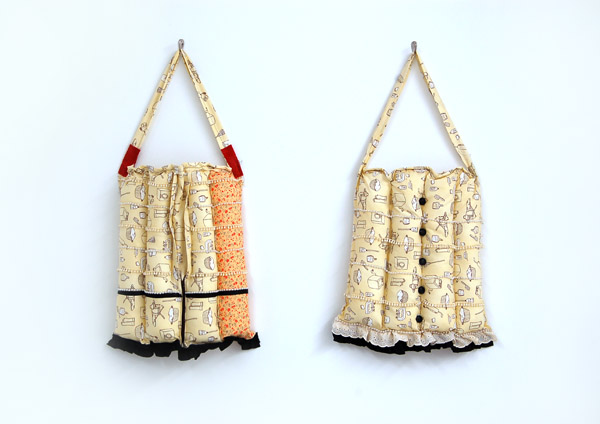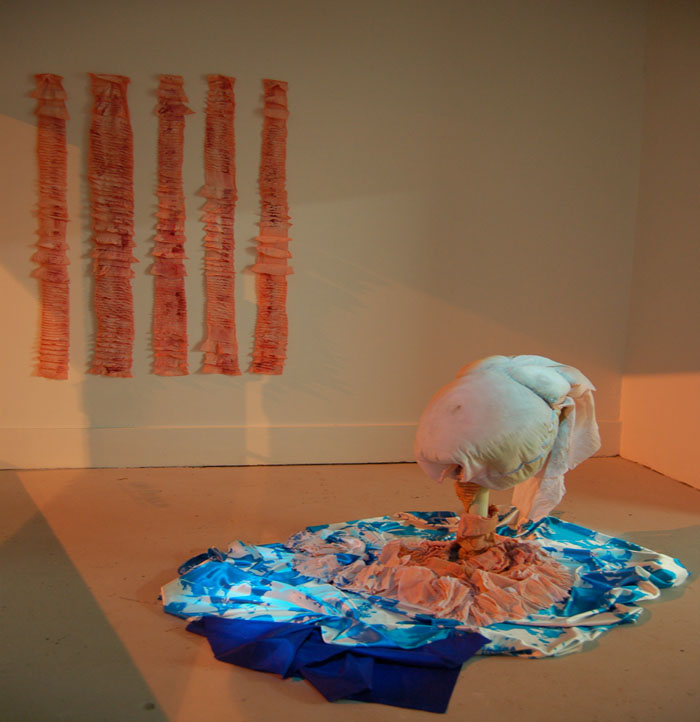In maamaandaawinam, (she has a vision), bezhik anungo kwe - Roxanne Martin creates a series of fascinating and intriguing soft sculpture works that represent her visions rooted in her culture. Her series of fabric sculptures and installations blend personal biography with humour, cultural belonging, and social critique to create a magical world of strange forms. Her work creates an imaginary space inhabited by exaggerated forms that defamiliarize the viewer to both the fabric itself and the subject matter depicted in Martin’s sculptures.
The use of fabric as a central material began with Martin’s initiative to create Ojibway moowin children’s language books out of fabric. As a cultural practice Martin’s artwork and her work as an educator is rooted in her experience as a mother and in her childhood. Martin’s approach to sewing the forms decolonizes the conventional methodologies of sewing in that she does not follow a pattern but creates her forms through freestyle use of the sewing machine. Using stuffed fabric allows Martin to engage the viewer’s inner child and asks them to remember the times when we could more easily believe in the magic of the world.
As a series of devices, magic realism, like telescopes, microscopes and polarized filters, offers us a way of seeing truth somehow excluded from our vision. The world can be both true to itself and true to its books; true to the intellect and true to the imagination. [1]
Through her sculptures Martin creates a sense of the absurd and strange that inhabit our everyday world. The works are fabric but they are not, they are more than that, Martin’s visions transform her fabric to create personal narratives that tell her story.
[1] Hancock, Geoff, ed. Introduction. Magic Realism. Toronto: Aya Press, 1980
The use of fabric as a central material began with Martin’s initiative to create Ojibway moowin children’s language books out of fabric. As a cultural practice Martin’s artwork and her work as an educator is rooted in her experience as a mother and in her childhood. Martin’s approach to sewing the forms decolonizes the conventional methodologies of sewing in that she does not follow a pattern but creates her forms through freestyle use of the sewing machine. Using stuffed fabric allows Martin to engage the viewer’s inner child and asks them to remember the times when we could more easily believe in the magic of the world.
As a series of devices, magic realism, like telescopes, microscopes and polarized filters, offers us a way of seeing truth somehow excluded from our vision. The world can be both true to itself and true to its books; true to the intellect and true to the imagination. [1]
Through her sculptures Martin creates a sense of the absurd and strange that inhabit our everyday world. The works are fabric but they are not, they are more than that, Martin’s visions transform her fabric to create personal narratives that tell her story.
[1] Hancock, Geoff, ed. Introduction. Magic Realism. Toronto: Aya Press, 1980
Installation view: The Bird Clan Social , fabric, stuffing, sticks and ironing board, 2013 (foreground) Always flip your dabber caps, stuffed fabric, 2013 (background)
Installation view: The Bird Clan Social , fabric, stuffing, sticks and ironing board, 2013
The Bird Clan Social , fabric, stuffing, sticks and ironing board, 2013 (detail)
Always flip your dabber caps, stuffed fabric, 2013
Installation view: Always flip your dabber caps, stuffed fabric, 2013 (foreground), Under the “I” hate bingo, fabric, stuffing, embroidery, 2013 (background)
Under the “I” hate bingo, fabric, stuffing, embroidery, 2013
Jingling to “civilization”, fabric, stuffing, notions, 2013
Jingling to “civilization”, fabric, stuffing, notions, 2013
niibish ninaamaa, fabric, stuffing, paint, single channel video projection, 2013 (day view)
niibish ninaamaa, fabric, stuffing, paint, single channel video projection, 2013 (night view)











